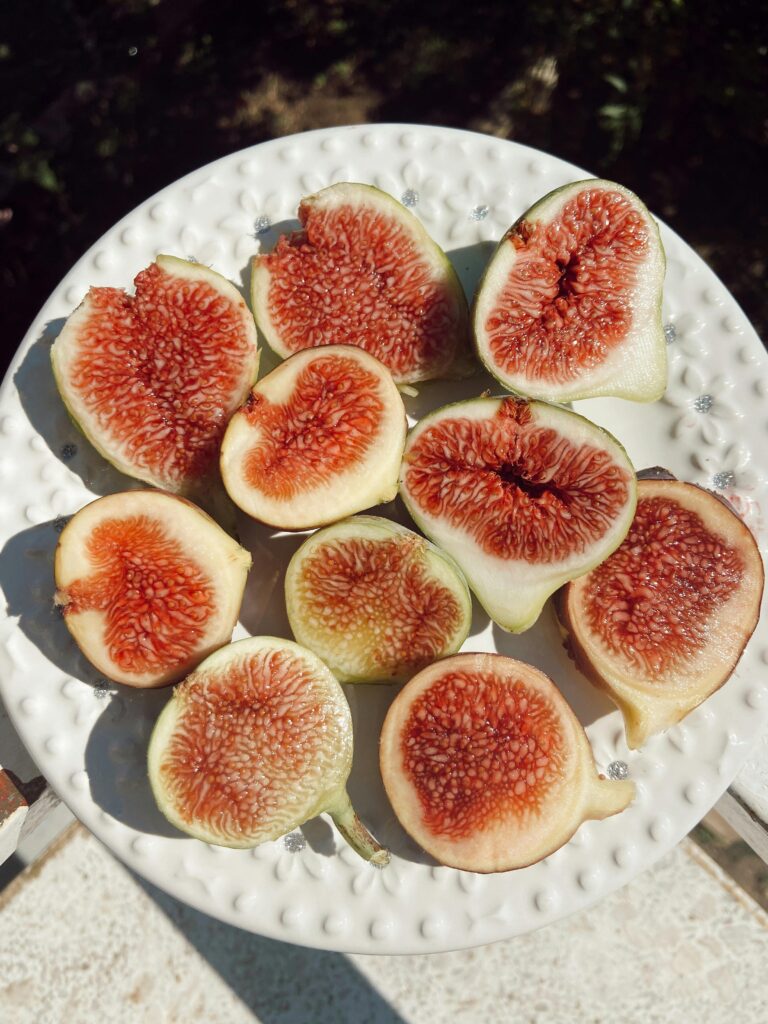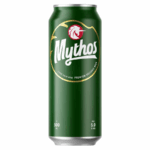Greek Figs: A Unique, Natural Sweetness
Greek figs are an emblematic fruit of the Mediterranean basin. They are renowned for their unique taste, natural sweetness and health benefits. Cultivated since ancient times, they occupy a special place in Greek culture and cuisine. Greece’s warm climate and fertile soils provide ideal conditions for growing fig trees. These figs, whether fresh or dried, are appreciated for their rich flavor and melt-in-the-mouth texture. As a result, they are considered one of the world’s finest products.
The Origins of Greek Figs: An Ancestral Story
Figs have played a central role in Greek history for thousands of years. The first traces of fig tree cultivation date back to Minoan times, around 2500 BC, in Crete. The fruit quickly found its place in daily life, both in the kitchen and in religious rituals. In ancient Greece, figs were considered a sacred food. They were often offered to the gods and used in religious ceremonies. They symbolized prosperity and fertility. According to Greek mythology, they were associated with Demeter, goddess of the harvest and the earth. Demeter is said to have encouraged the cultivation of figs, associated with soil fertility and abundance.
Figs weren’t just a sacred fruit. They were also a staple food for the Greeks. In the writings of Homer and the accounts of Greek philosophers, figs are often praised for their delicious taste and nutritious properties. They were essential for Greek soldiers, because of their ability to provide fast, long-lasting energy. Fig cultivation thus developed, influenced by various Mediterranean civilizations. Over the centuries, cultivation techniques have evolved, incorporating know-how from the Egyptians, Romans and other Mediterranean peoples. This contributed to making Greek figs a quality product, recognized throughout the ancient world and beyond.
Fig-Producing Regions in Greece: A Living Tradition
Figs are grown in many parts of Greece. Each region has its own geographical and climatic particularities, influencing fruit quality. Some areas are particularly renowned for the exceptional quality of their figs, which have become world-famous.
The Kymi Region: A jewel on the island of Evia
The Kymi region on the island of Evia is famous for its dried figs. They are renowned for their intense sweetness and soft texture. These figs are protected by a Protected Designation of Origin (PDO), guaranteeing their quality and origin. Kymi’s fig trees benefit from a unique microclimate, where the Mediterranean sun and sea breezes promote perfect ripening of the fruit. The clay soil, rich in minerals, gives figs a sweet taste and a pleasant consistency. They are highly prized in the production of dried figs.
Messinia: The Fertile Land of the Peloponnese
Messinia, in the Peloponnese, is another major fig-growing region. Fig trees thrive here thanks to rich soil and a warm, sunny climate. The fig variety grown in this region is distinguished by its firm texture and slightly tart flavor. Fresh water from the surrounding mountains irrigates the land and enriches the fig trees. This contributes to a harvest of excellent quality figs.
Cyclades and Aegean Islands : Fresh Figs with an Incomparable Taste
The Aegean islands, especially the Cyclades, are famous for their high-quality figs, often eaten fresh. Fig trees grown in this region benefit from rich volcanic soils and a dry, warm climate. These conditions allow the figs to develop powerful aromas and a juicy texture. The proximity of the sea and sea breezes also influence their taste, making them sweeter and tastier.
Comparison of Fig-growing regions in Greece
Geographical features: Warm microclimate and sea breezes, clay soil
Type of figs: Kymi dried fig
Characteristics: Intense sweetness, soft texture
Geographical features: Rich soil, sunny climate
Types of figs: Black and green figs
Characteristics: Firm texture, slightly tart flavour
- Cyclades (Aegean Islands)
Geographical features : Volcanic soils, dry, warm climate
Type of fig : Fresh fig
Characteristics :Powerful aromas, juicy texture
Economic Impact and Production Statistics
Figs play an essential role in the local economy of these regions. In 2020, Greece produced around 100,000 tonnes of figs. Much of it comes from these key production areas. Fig production, particularly in Kymi and Messinia, contributes to Greek food exports. This generates income for local agriculture. The international market, especially in Europe, is in great demand for quality figs. Greece is one of the world’s leading exporters of dried figs.
The Different Varieties of Greek Figs
In Greece, several varieties of fig are grown, each with its own distinct characteristics in terms of taste, texture and culinary uses. These sun-drenched figs are the fruit of ancestral know-how, handed down from generation to generation.
Kymi's White Fig
The white Kymi fig is particularly sweet and has a thin skin. Its soft, tender flesh makes it ideal for dried consumption.
Mainly used to produce dried figs, it is also used in traditional desserts such as fig cakes and jams.
Kymi figs have a Protected Designation of Origin (PDO), which guarantees their quality and origin. The local people are very proud of this variety, which is grown with particular care.
Black Fig
Black figs are more intense in flavor, with thicker skin and denser flesh. They are often slightly tart and sweet at the same time, giving them a particular aromatic richness.
Often eaten fresh, they are also used in savory dishes, such as meat stews, or in summer salads. They add a sweet, complex touch to many dishes.
In some regions, black figs are used to make fig wine, a local specialty dating back to ancient times.
The Kalamata Fig
Although best known for its olives, Kalamata also produces a fig characterized by its firm texture and sweet flavor. The Kalamata fig has a thick skin and slightly grainy, but very juicy flesh.
It is often used in Mediterranean dishes, particularly desserts and sauces, because of its ability to hold its shape when cooked. It is also eaten fresh in certain salad recipes.
The Kalamata fig is a well-kept secret of the local regions. It is often sold at farmers’ markets as a specialty product that represents the authentic taste of the region.
The Thassos Fig
The Thassos fig is a lesser-known variety with a rich taste. It is often smaller than other figs, with a thin skin and a sweet, slightly tart flavor.
Mostly eaten fresh, it is ideal for salads or as a light snack. It can also be dried, but this is less common in industrial recipes.
Thassos figs are harvested mainly from family orchards, where they are often dried at home. They have a special place in family cooking, often served with local honey.
Local and Traditional Varieties
Many Greek regions cultivate local varieties that are not always well known internationally, but are an essential part of the regional culinary culture. These figs can vary in size, color and texture, offering a range of flavors.
These varieties are used mainly in local recipes, such as fig bread, fig cakes, and as garnish in traditional Mediterranean dishes.
Each village has its own fig varieties, often handed down through the generations. In some regions, figs are even used for religious ceremonies or as offerings at local festivals.
Health benefits of Figs
Greek figs aren’t just delicious, they’re also packed with health benefits. They are a natural source of fiber, promoting healthy digestion and regulating intestinal transit. Figs are also rich in antioxidants. These play a key role in protecting cells against oxidative damage. This helps prevent chronic disease and slow cellular aging.
Research-proven benefits
A number of recent studies have highlighted the benefits of figs for cardiovascular health. For example, research shows that regular consumption of figs helps reduce LDL (“bad”) cholesterol levels. This is due to their high soluble fiber and antioxidant content. Figs are also beneficial for digestion, thanks to their pectin content, a soluble fiber that nourishes the good bacteria in the intestine.
What’s more, figs are an excellent source of potassium, an essential mineral for maintaining healthy blood pressure and supporting healthy heart function. Their magnesium and calcium content is beneficial for bone and muscle health. This strengthens body structure and muscle function.
Figs in Special Diets
Figs are an excellent choice in many diets, especially for those who adopt healthy eating habits.
- Vegetarian and vegan diets
Figs are rich in fiber, minerals and vitamins, making them ideal for a vegetarian or vegan diet. They offer a natural source of sugar and energy without animal products.
Figs are naturally gluten-free, making them an excellent addition to gluten-free diets. They are a sweet and healthy alternative for those who avoid gluten-containing cereals.
Thanks to their low glycemic index, figs are an ideal sweet option for those watching their blood sugar levels. They satisfy sweet cravings with minimal impact on blood sugar levels.
How to incorporate Figs into your daily diet?
Figs are incredibly versatile and can be incorporated into many recipes. Here are some ideas for including them in your daily diet:
Add fresh or dried figs to your smoothies for a natural sweetness. Blend with bananas, spinach and a little almond milk for a nourishing smoothie.
Use fresh or dried figs to liven up your salads. They go perfectly with goat’s cheese, feta, walnuts and fresh herbs.
Mix dried figs with nuts, such as almonds or pecans, for a healthy, high-energy snack.
Use dried figs in cakes, tarts or crumbles to add sweetness without refined sugar. They add a rich, natural flavor.
Figs go well with grilled meats such as lamb or pork. You can also add them to sauces for a sweet, complex touch.
Figs in Greek Cuisine: A Versatile Ingredient
Greek figs are an essential ingredient in Mediterranean cuisine, used in both sweet and savory dishes. Their natural sweetness and melt-in-the-mouth texture enrich many recipes, whether fresh or dried. Figs are not only delicious, they also add a unique depth of flavor to both traditional and contemporary dishes.
Traditional Greek recipes with Figs
- Karydopita (Walnut and fig cake) :
This cake, rich in nuts and dried figs, is a traditional Greek specialty. Figs add a natural sweetness that blends perfectly with crunchy walnuts and cinnamon, creating a fragrant, nourishing dessert.
Recipe: Mix crushed walnuts, chopped dried figs, flour, sugar and eggs. Add a little honey to enhance the sweetness of the figs, then bake. Serve with a touch of honey-based sugar syrup.
- Moussaka with dried figs:
A modern twist on the classic moussaka dish. By adding chopped dried figs to the tomato sauce, you get a sweet note that balances the richness of the lamb meat and creamy béchamel sauce.
Recipe: Prepare moussaka as usual, stirring dried figs into the tomato sauce with garlic and spices. This will give a deeper taste and a pleasant texture.
- Fresh Fig Salad with Goat Cheese and Local Herbs:
A refreshing and tasty summer salad. Fresh figs go perfectly with creamy goat’s cheese, honey and local herbs like oregano and thyme.
Recipe: Mix sliced fresh figs with crumbled goat’s cheese, toasted pecans, fresh herbs and a drizzle of honey. Season with salt, pepper and extra-virgin olive oil.
Modern Associations: Figs in Contemporary Gastronomy
Figs are not limited to traditional dishes; they are also used in modern creations, including cocktails and gourmet cuisine.
Fresh or dried figs can be used to make creative cocktails. For example, a fig and gin cocktail or a fig mojito adds a sweet, exotic touch to classic drinks. Homemade fig syrup, made with figs, sugar and water, can also be a great addition to give body to a cocktail.
- Gastronomic dishes created by contemporary chefs
Modern chefs use figs in refined dishes. For example, they go well with foie gras, or mature cheeses such as blue or parmesan. Figs can also be added to meat dishes, where their sweetness offsets the richness of roasted meats.
Example: Duck breast with roasted figs. The figs are roasted with honey and spices to accompany the tender duck meat. This creates the perfect combination of sweet and savory.
The Fig Drying Process: Traditional Know-How
Fig drying is an age-old tradition in Greece. It preserves this tasty fruit all year round. Producers harvest the figs by hand when they are fully ripe, then arrange them on wooden trays to dry in the open air under the Mediterranean sun. This natural process can last several days, depending on the intensity of the sun and climatic conditions. In this way, figs gradually lose their water while concentrating their natural sugars, which improves their flavor. The aim is to make the figs lose water while concentrating their natural sugars. This enhances their sweetness and flavor.
Drying Methods and Quality Assurance
Drying quality depends on several key factors:
Greece’s warm, dry climate, especially in regions such as Kymi and Messinia, provides ideal conditions for this natural process. Intense sunlight and dry air evaporate the water from the figs without altering their taste or nutritional benefits.
Traditionally, figs are laid out on wooden trays or trellises. This allows air to circulate freely around the fruit. This method ensures slow, even drying, preserving the figs’ soft texture and concentrating their flavor.
To guarantee optimum quality, our growers select only ripe, undamaged fruit. Some use protective netting to prevent the figs being damaged by insects or dust during drying.
Nutritional benefits of dried figs
Drying figs concentrates not only their flavor, but also their nutritional properties. Compared with fresh figs, dried figs are richer in certain nutrients. As the water evaporates, their nutritional density increases.
Dried figs contain a higher level of dietary fiber than fresh figs. These fibers are essential for healthy digestion and regulating intestinal transit.
The drying process helps concentrate the antioxidants. These protect cells against free radicals and help prevent chronic diseases.
Dried figs are an excellent source of potassium, calcium and magnesium, essential minerals for bone and heart health. They also contain polyphenols, which have anti-inflammatory properties.
Due to the concentration of sugar during drying, dried figs provide a natural source of energy. They’re ideal for athletes or those in need of a boost throughout the day.
Dried figs are also very practical. They keep for a long time while maintaining their nutritional quality. They’re an excellent option for those looking for a healthy snack, rich in energy and nutrients.
Greek Fig Festivals and Celebrations
Figs occupy a special place in local festivals and celebrations in Greece. They symbolize the fertility of the land and Mediterranean culture. These events pay tribute to this delicious fruit and promote local traditions. They bring communities together around the richness of their culinary heritage.
The Kymi Fig Festival: An Unmissable Rendezvous
One of the most famous festivals is the Kymi Fig Festival, held every year on the island of Evia, in the town of Kymi. The festival attracts visitors from all over Greece and beyond, eager to discover the region’s figs, renowned for their exceptional quality.
Visitors can take part in fig harvesting and drying demonstrations. They learn the traditional techniques used to prepare dried figs. The organizers also run cooking workshops, where participants learn how to prepare local fig-based dishes such as Karydopita (walnut and fig cake) and Mediterranean salads.
The festival stands offer a wide range of fig-based products: dried figs, jams, fig liqueurs and even traditional pastries. Local figs, particularly Kymi figs, are the stars of the event. Visitors can sample a variety of products prepared with this emblematic fruit.
- Historical and cultural significance
This festival is much more than just a culinary event. It is also a celebration of the agricultural traditions that have shaped the region. The traditional dryer, used to dry figs, is part of the local heritage and remains a symbol of sustainable farming practices. The festival is also an opportunity to recall the importance of figs in Kymi’s economic history, where their cultivation has contributed to the region’s identity.
Other Local Fig Festivals
Other Greek villages and regions also celebrate figs with local festivals. For example:
Held in the Peloponnese, this festival puts the spotlight on the region’s black figs, prized for their unique flavor. Visitors can take part in tastings and culinary workshops. They can also explore by-products such as fig wine and fig paste, used in local cuisine.
On the island of Naxos, locals celebrate fig production with folk dances, concerts and traditional cooking workshops. Fresh figs, grown on the island’s volcanic soils, feature in both savory and sweet dishes.
Impact on local communities
These festivals don’t just celebrate figs. They also play a key role in preserving local traditions and promoting rural tourism. They enable local farmers to showcase their know-how. At the same time, these events offer visitors an immersive experience of authentic Greek culture. These festivals support the local economy by attracting tourists, promoting direct sales of local produce and creating temporary jobs.
Fig festivals are also an opportunity to strengthen the sense of community. Locals come together to share their stories, recipes and passion for growing figs. This creates a real bond between generations and a sense of regional pride.
Exporting Greek Figs: an internationally sought-after product
Greek figs, especially those from Kymi, attract strong demand beyond Greece’s borders. Their exceptional quality and incomparable taste make them a star product on international markets. In particular, Greek dried figs stand out in gourmet markets. Chefs and pastry chefs the world over use them to create refined desserts and innovative dishes.
Data on Greek Fig exports
In 2020, Greece exported around 70,000 tonnes of figs to international markets. This represents almost 70% of the country’s total fig production. Among the main export destinations for Greek figs are countries such as :
Germany imports the largest quantity of Greek figs in Europe, especially dried figs.
Demand is strong, especially for high-quality figs. They specialize in luxury gastronomy and refined products.
- The United Kingdom and France
These countries are among the leading European markets for fresh and dried figs.
Greek figs are popular in countries such as the United Arab Emirates and Saudi Arabia, where they are used in traditional cooking and desserts.
Greek figs are also gaining in popularity in regions such as Asia and Australia, where demand for quality Mediterranean products continues to grow.
Testimonials from International Chefs
Many international chefs use Greek figs in their culinary creations. French Michelin-starred chef Alain Ducasse uses Greek figs in desserts such as fig tarts and sorbets. According to him:
“Greek figs bring an incomparable richness to my dishes. Their natural sweetness and perfect texture make them ideal for refined desserts.”
Similarly, Giada De Laurentiis, famous Italian chef, often talks about her passion for Kymi’s dried figs. She uses them in her Mediterranean recipes. She states:
“Greek figs are the key element in my salad and meat recipes. Their unique flavor and chewy texture add an incredible dimension to my dishes.”
Greek Fig Quality Standards and Certifications
Greek figs benefit from quality certifications, guaranteeing their origin and superior quality. For example, Kymi fig growers protect their figs with a Protected Designation of Origin (PDO). This label attests to their geographical origin and the traditional growing methods used. This guarantees that the figs comply with strict production and processing criteria.
In addition, Greek figs must meet European and international food safety and quality control standards. Consequently, regular inspections verify their compliance with sanitary, freshness and taste requirements. These certifications enable Greek figs to maintain a solid reputation on international markets. They also support sustainable agricultural practices.
How to Select and Store Greek Figs
To enjoy Greek figs to the full, it’s essential to know how to choose and store them properly. Whether you’re buying fresh or dried figs, there are practical tips to ensure their quality and longevity.
Choosing Fresh Figs
Fresh figs should be firm but slightly soft to the touch, with smooth, intact skin. They should be free of brown spots or cracks, which could indicate over-ripening or damage.
Fresh figs are best stored in the refrigerator to prolong their freshness. Place in a perforated basket or container to allow air to circulate around the fruit. Figs should be eaten soon after purchase, preferably within 2 to 3 days.
Choosing dried figs
Dried figs should be plump, soft and mold-free. A good-quality dried fig should have a supple texture and be slightly sticky to the touch. Avoid figs that look hard, dehydrated or too dry, as this can affect their taste and texture.
Dried figs should be stored in a cool, dry place, away from humidity and heat. Ideally, keep them in an airtight container to maintain their freshness and taste. You can keep figs for several months, even up to a year, if you store them properly. For an even longer shelf life, you can put them in the freezer.
How to Buy Online
When buying figs online, be sure to check the origin of the product. Choose figs bearing a Protected Geographical Indication (PGI) or a Protected Designation of Origin (PDO). These labels guarantee the origin and quality of the product.
- View reviews and certifications
Read customer reviews and check quality certifications. This will ensure that the figs come from reputable growers and meet strict food safety standards.
Make sure the figs come from regions renowned for their high-quality fig production, such as Kymi, Messinia or the Cyclades, regions famous for their exceptional figs.
Cooking tips: How to rehydrate dried figs
Dried figs can be an excellent ingredient in a variety of recipes, both sweet and savoury. Here are a few tips for rehydrating them and incorporating them into your dishes:
To rehydrate dried figs, place them in a bowl of lukewarm water for about 30 minutes. This will make them softer and ideal for incorporating into pastries, cakes or salads.
- Rehydration for savoury dishes
If you’re using dried figs in savory dishes such as meat stews, rehydrate them in stock or red wine. This will add richness and a touch of sweetness to the sauce.
- Rehydration for smoothies
To use dried figs in smoothies, rehydrate them in water or orange juice for a few hours. Then blend with fresh fruit for a sweet, energizing drink.
Greek Figs: A Cultural and Gastronomic Heritage
Greek figs are much more than just a fruit. They symbolize Mediterranean culture and are a heritage handed down from generation to generation. Whether through their role in mythology, their place in religious rituals or their use in cooking, figs were deeply rooted in Greek daily life. Today, they remain an essential part of the diet and an ambassador of Greece’s culinary richness around the world.
Greek figs, with their unique taste and multiple benefits, are a real treasure to be discovered and enjoyed. They symbolize abundance and generosity, values deeply rooted in Mediterranean culture.
Selection of cookery books and cultural items
To learn more about the importance of figs in Greek and Mediterranean culture, here’s some fascinating reading suggestions:
- “The Mediterranean Diet” by Nancy Harmon Jenkins
This book explores the impact of the Mediterranean diet on health, with recipes featuring figs and other local fruits.
- “My Big Fat Greek Cookbook” by Angie Sappho
An excellent resource for discovering traditional Greek recipes, including several featuring figs in sweet and savory dishes.
- “Figgs & Pigs: The Mediterranean Way” by Vanessa Woolf
This book combines stories and recipes related to the fig, while exploring its role in Mediterranean cultures.
- “Greek Cooking: The Secrets of the Greek Kitchen” by Barbara Kafka
A must-have reference for anyone wishing to explore Greek cuisine, including typical dishes using fresh or dried figs.
Figs as a flagship product of Mediterranean gastronomy
Figs play a central role in Mediterranean gastronomy. Chefs use them in a multitude of traditional and contemporary dishes throughout Greece, as well as in other Mediterranean countries. In North African, Middle Eastern and southern Spanish cuisine, figs often accompany meats such as lamb or duck. They create a delicious sweet-savory contrast. Figs are also a key ingredient in jams, pastries and desserts. To enhance your dishes with that typical sweet touch, fig balsamic cream is ideal drizzled over roasted vegetables, mature cheese or even a fruity dessert.
To further explore the use of figs in Mediterranean cuisine, here are a few additional articles to read:
- “The Role of Figs in Mediterranean Cuisine”.
This article explores the many ways figs are used in traditional Mediterranean cuisine.
- “Mediterranean Flavors: The Influence of Fig on Regional Cuisines”.
An article detailing the cultural and gastronomic impact of figs in Mediterranean cuisine.
Our Greek fig products

















